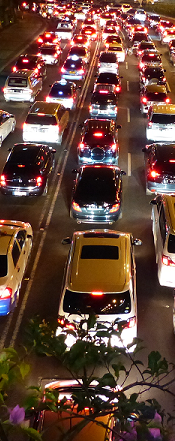Car Sales in Indonesia Grow 8.2% in February Backed by LCGC Demand
Car sales in Indonesia grew 8.2 percent (year-on-year) to 111,767 vehicles in February 2014 according to the latest data from the Association of Indonesian Automotive Manufacturers (Gaikindo). As usual, car sales were dominated by Toyota, Daihatsu (both are distributed by Astra International, one of Indonesia's largest diversified conglomerates), Mitsubishi, Suzuki and Honda. February sales were supported by the popular low-cost green car (LCGC) that was introduced on Indonesia's market in 2013.
The LCGC type accounted for about 15 percent of total sales in February 2014. Through tax incentives, the Indonesian government stimulated the establishment of a LCGC industry in Indonesia, provided that these car manufacturers meet requirements of fuel efficiency targets. This is one strategy of the government to curb both domestic fuel demand and expensive imports of oil. With an average price tag of around IDR 100 million (USD $8,850), these LCGCs proved highly popular on the Indonesian market. The five principal car brands that participate in this LCGC program are Astra Toyota Agya, Astra Daihatsu Ayla, Suzuki Wagon R, and Honda Brio Satya. Business consulting firm Frost & Sullivan expect that Indonesian LCGC sales will grow by 125 percent to 125,000 in 2014 from 51,000 in 2013.
Gaikindo expects that a total of 1.2 to 1.3 million cars will be sold on the Indonesian market in 2014, roughly similar to last year's result. Johnny Darmawan, deputy chairman of Gaikindo, said that he believes there is a chance of moderating car sales during and after the legislative and presidential elections in April and July 2014 if the election does not run smoothly. Despite the popularity of the LCGC, Indonesia's car sales are expected to be stagnant in 2014 due to the higher interest rate environment (the central bank raised its benchmark interest rate gradually from 5.75 percent in June 2013 to 7.50 percent in November 2013), high inflation (7.75 percent year-on-year in February 2014 thus reducing people's purchasing power), and the slowing economy (Indonesia's gross domestic product growth slowed from 6.23 percent in 2012 to 5.78 percent in 2013). The higher interest rate environment is expected to continue in 2014, while inflation is showing an easing trend in recent months and may be kept within the central bank's target range of 3.5 to 5.5 percent. Economic growth of Indonesia in 2014 is estimated to reach around 5.7 percent, similar to last year's result.
Car sales - similar to cement and motorcycle sales - are an important indicator to measure the current state of household consumption. Household consumption accounts for around 55 percent of total economic growth in Indonesia.
However, increasing car sales burden the already fragile condition of Indonesia's infrastructure.
Indonesian Car Sales (CBU):
| Month | Sold Cars 2012 | Sold Cars 2013 | Sold Cars 2014 |
| January | 76,427 | 96,718 | 103,510 |
| February | 86,486 | 103,279 | 111,767 |
| March | 87,917 | 95,996 | |
| April | 87,144 | 102,257 | |
| May | 95,541 | 99,697 | |
| June | 101,746 | 104,268 | |
| July | 102,511 | 112,178 | |
| August | 76,445 | 77,964 | |
| September | 102,100 | 115,973 | |
| October | 106,754 | 112,039 | |
| November | 103,703 | 111,841 | |
| December | 89,456 | 97,694 | |
| Total | 1,116,230 |
1,229,904 |
215,277 |
| 2008 | 2009 | 2010 | 2011 | 2012 | 2013 | 2014¹ | |
| Indonesia's Car Sales (number of car units) |
607,805 | 486,061 | 764,710 | 894,164 | 1,116,230 |
1,229,904 | 1,250,000 |
| Indonesia's Exports (number of car units) |
100,982 | 56,669 | 85,769 | 107,932 | 173,368 | 170,907 | 200,000 |
¹ future forecast
Source: Gaikindo
Further Reading:
• Car Sales, Production and Exports of Indonesia Estimated to Grow in 2014
• Car Sales in Indonesia Unaffected by Weather Conditions in January 2014
• Expansion of Indonesia's Automotive Industry: Raising Exports to Asia
• Car Sales in Indonesia Expected to Rise in 2014 amid Political Elections
• Popular Low Cost Green Car Boosts Indonesian Car Sales in 2013
• Gaikindo Targets 10% Car Sales Growth in Indonesia for 2014
Bahas
Silakan login atau berlangganan untuk mengomentari kolom ini


